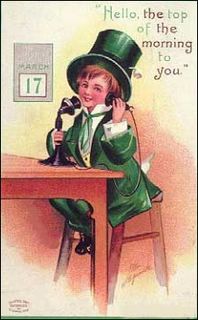Thought for Today
Irish Blessing
May you always have work for your hands to do,
May your pockets hold always a coin or two,
May the sun shine bright on your windowpane,
May the hand of a friend always be near you,
And may God fill your heart with gladness to cheer you.
A place on the web to preserve our family history! Email stanmoffat@gmail.com for details or information, etc. This a work in progress...
Thursday, March 17, 2005
St. Pat's Day ... wishing you all things green...haha...

Happy St. Pat's Day to everyone.. here is what a friend of mine wrote about the day. JJ is the drummer for the band The Great Divide and he send this note...
Wednesday, March 16, 2005
St. Patrick's Day is celebrated on March 17, his religious feast day and the anniversary of his death in the fifth century. The Irish have observed this day as a religious holiday for thousands of years. On St. Patrick's Day, which falls during the Catholic season of Lent, Irish families would traditionally attend church in the morning and celebrate in the afternoon. Lenten prohibitions against the consumption of meat were waived and people would dance, drink, and feast—on the traditional meal of Irish bacon and cabbage.
The first St. Patrick's Day parade took place not in Ireland, but in the United States. Irish soldiers serving in the English military marched through New York City on March 17, 1762. Along with their music, the parade helped the soldiers to reconnect with their Irish roots, as well as fellow Irishmen serving in the English army. Over the next thirty-five years, Irish patriotism among American immigrants flourished, prompting the rise of so-called "Irish Aid" societies, like the Friendly Sons of Saint Patrick and the Hibernian Society. Each group would hold annual parades featuring bagpipes (which actually first became popular in the Scottish and British armies) and drums.
Up until the mid-nineteenth century, most Irish immigrants in America were members of the Protestant middle class. When the Great Potato Famine hit Ireland in 1845, close to a million poor, uneducated, Catholic Irish began to pour into America to escape starvation. Despised for their religious beliefs and funny accents by the American Protestant majority, the immigrants had trouble finding even menial jobs. When Irish Americans in the country 's cities took to the streets on St. Patrick's Day to celebrate their heritage, newspapers portrayed them in cartoons as drunk, violent monkeys. However, the Irish soon began to realize that their great numbers endowed them with a political power that had yet to be exploited. They started to organize, and their voting block, known as the "green machine," became an important swing vote for political hopefuls. Suddenly, annual St. Patrick's Day parades became a show of strength for Irish Americans, as well as a must-attend event for a slew of political candidates. In 1948, President Truman attended New York City 's St. Patrick's Day parade, a proud moment for the many Irish whose ancestors had to fight stereotypes and racial prejudice to find acceptance in America.
JJ
Subscribe to:
Comments (Atom)